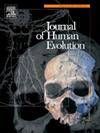泰国甲米古近纪Siamopithecus eocaenus(类人猿,灵长类)的上颌骨及其分类学地位。
IF 3.1
1区 地球科学
Q1 ANTHROPOLOGY
引用次数: 0
摘要
本文详细描述了从泰国半岛甲米盆地最晚始新世/最早渐新世褐煤矿中发现的暹罗猿(Siamopithecus eocaenus)的上颌骨。其中包括 P3-M3、上颚、部分眼眶区域和颧骨根的形态。该标本具有独特的牙齿特征,包括单根的 P2齿槽、P3 和 P4 上的原臼齿以及上臼齿上的真下臼齿,这表明该标本具有衍生的人类牙齿。面部解剖学的比较研究和虚拟重建显示,它与昼伏夜出的类人猿而非非哈氏链齿兽有着密切的亲缘关系。Siamopithecus的重建面部形态显示出短而反向的面部、显著的眼眶会聚(72.1°)和前倾(81.6°),使其有别于化石和现存的链皮目。此外,从颧骨上部保留区域的远端延伸出的薄骨层表明眶后部分或完全闭合。系统发育分析表明,暹罗猿属于两栖类,但最近的形态学观察结果对这一观点提出了质疑,因此提出了一个更高的科群--暹罗猿科。通过与已知最原始的非洲-阿拉伯脯兽类--阿曼的塔卡脯兽类--进行比较,发现它们的臼齿结构相似,但齿式(保留 P2)和前臼齿结构不同。在没有当地祖先的情况下,原角类人突然出现在非洲-阿拉伯地区的渐新世早期,这引起了关于原角类人起源于亚洲还是非洲的争论。然而,另一种观点则基于与低鼻类人猿的姊妹群关系,支持前鼻类人猿起源于非洲,而该地区尚未有文献记载。这项研究为早期类人猿的进化史提供了新的见解,提出了一个涉及亚洲和非洲两系的复杂的生物地理情景。本文章由计算机程序翻译,如有差异,请以英文原文为准。
Maxilla of Siamopithecus eocaenus (Anthropoidea, Primates) from the Paleogene of Krabi, Thailand, and its taxonomic status
Detailed descriptions of the maxillae of Siamopithecus eocaenus, discovered from the latest Eocene/earliest Oligocene lignite mine in the Krabi basin of Peninsular Thailand, are presented. They include the morphology of P3–M3, the palate, a partial orbital region, and the zygomatic root. The specimen exhibits distinctive dental features including a single-rooted P2 alveolus, a protocone on the P3 and P4, and a true hypocone on the upper molars, indicating its derived anthropoid dentition. Comparative studies and virtual reconstructions of the facial anatomy reveal close affinities with diurnal anthropoids rather than the notharctid strepsirrhines. The reconstructed facial morphology of Siamopithecus displays a short and subvertically oriented face, significant orbital convergence (72.1°), and frontation (81.6°), distinguishing it from both fossil and extant strepsirrhines. Moreover, the presence of a thin bony lamina extending from the distal part of the upper preserved area of the zygomatic suggests partial or complete postorbital closure. Phylogenetic analyses suggest an affiliation with amphipithecids, but recent morphological observations challenge this, leading to the proposal of an elevated family-group ranking, Siamopithecidae. Comparison with the most primitive known Afro-Arabian propliopithecid, the Taqah propliopithecid from Oman, reveals similarities in their molar structure but differences in dental formula (retention of P2) and premolar structure. The abrupt appearance of propliopithecids in the early Oligocene of Afro-Arabia, without a local ancestor, contributes to the debate on whether catarrhine origins were in Asia or Africa. However, alternative views, based on sister-group relationships with oligopithecids, support an African origin of propliopithecids from an undocumented Afro-Arabian region. This research provides new insights into the evolutionary history of early anthropoids, suggesting a complex biogeographical scenario involving both Asian and African lineages.
求助全文
通过发布文献求助,成功后即可免费获取论文全文。
去求助
来源期刊

Journal of Human Evolution
生物-进化生物学
CiteScore
6.30
自引率
15.60%
发文量
104
审稿时长
3 months
期刊介绍:
The Journal of Human Evolution concentrates on publishing the highest quality papers covering all aspects of human evolution. The central focus is aimed jointly at paleoanthropological work, covering human and primate fossils, and at comparative studies of living species, including both morphological and molecular evidence. These include descriptions of new discoveries, interpretative analyses of new and previously described material, and assessments of the phylogeny and paleobiology of primate species. Submissions should address issues and questions of broad interest in paleoanthropology.
 求助内容:
求助内容: 应助结果提醒方式:
应助结果提醒方式:


